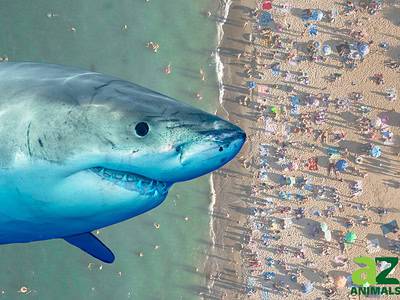Hedgehog
Thought to be one of the oldest mammals on Earth!
Advertisement
Hedgehog Scientific Classification
Read our Complete Guide to Classification of Animals.
Hedgehog Conservation Status
Hedgehog Facts
- Average Litter Size
- 5
- Lifestyle
- Solitary
- Favorite Food
- Insects
- Type
- Mammal
- Slogan
- Thought to be one of the oldest mammals on Earth!
View all of the Hedgehog images!
Hedgehogs are commonly described as an animal with spikes.
Their unique and descriptive name is due to the way that they forage for food with rather unique methods. For individuals that are willing to take them on as pets, they can be incredibly useful in the elimination of irritating garden insects and other pests.
The most notable feature of the hedgehog is its coat, which is comprised of stiff yet sharp spines. When in danger, they defend themselves by rolling into a ball, causing their spines to protrude and act as a defense against possible threats of danger.
Nocturnal in nature, hedgehogs are animals that are known to sleep throughout the day and wake up and start searching for food at night. They also hibernate in cold climate areas. There are 17 different species of hedgehogs that have some very interesting facts about them.
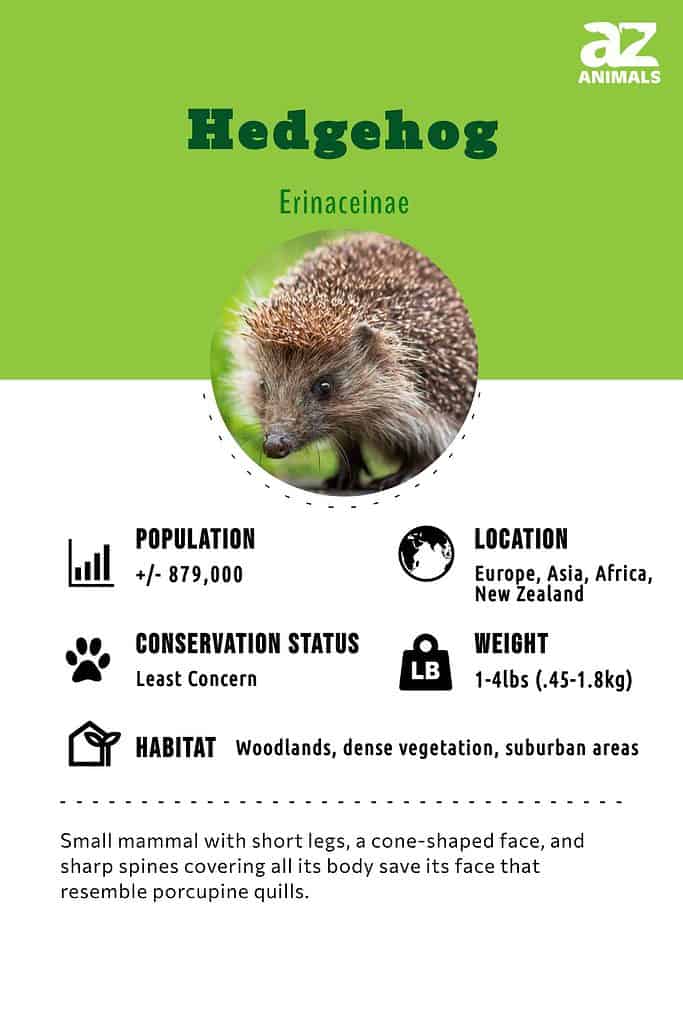
Incredible Hedgehog Facts!
- Hedgehogs curl up into a prickly ball when they sense danger or are attacked.
- They hibernate in areas within their natural environment.
- Their coat is made up of sharp spines, which they expose as a defense mechanism.
- These animals sleep throughout the day, waking up to search for food during the night.
- They help in eliminating common garden pests by eating them and are hence considered very useful pets.
- While hedgehogs may look like great pets, they are illegal to own in many states.
You can check out more incredible facts about hedgehogs.
Scientific Name
These animals with spikes go by the scientific name Erinaceinae. They belong to the kingdom Animalia and phylum Chordata. Their class is called Mammalia and the order is called Eulipotyphla. The family, Erinaceidae, covers both the hedgehog and the closely-related moonrat.
Erinaceinae is a combination of “Erinaceus” and the suffix “-inae.” Erinaceus is a genus that hedgehogs are included under, coming from the Latin word that simply means “hedgehog.” The root of the word – khḗr – is linked to the Greek word for hedgehog, paired with the root “ǵʰer,” which means “to be bristly.”
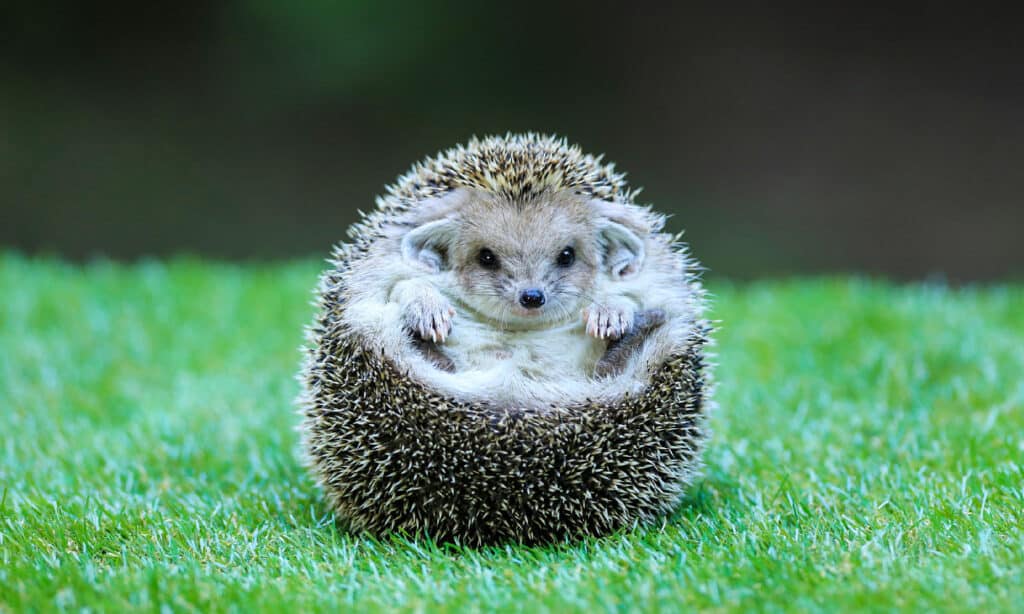
The hedgehog is closely related to
shrews, moles, and moonrats.
©iStock.com/serikbaib
Evolution
Scientists believe that hedgehogs were on the earth 15 million years ago, making them some of the oldest mammals still existent on the planet. They seem to share some characteristics with hogs, and one now-extinct species of hedgehog is the Mediterranean hedgehog, was the size of a pig. They do share distant ancestry with shrews.
Like some prehistoric animals, the hedgehog’s senses are based around smell rather than eyesight. They could have survived where other mammals perished due to their practice of hibernation, broad diet, and protective spines.
Types of Hedgehogs
Worldwide, there are 17 species of hedgehogs concentrated in Europe (especially Great Britain), Asia, Africa, and New Zealand. The types include:
- European Hedgehog – Native to Western Europe. Other names: West European hedgehog, common hedgehog. Largest and heaviest of the species, with most of its body covered by up to 6,000 brown and white spines.
- Four-toed Hedgehog – Native to Central and East Africa. Other names: African pygmy hedgehog. Found in savannah and cropland habitats. Known for its four toes, where others have five.
- Long-eared Hedgehog – Native to Central Asia and Arabia. Lives in burrows, and notable for its prominent ears.
- Southern African Hedgehog – Native to multiple countries in Africa. Dark brown with white spines that have dark brown tips.
- Desert Hedgehog – Native to desert habitats in Africa and Arabia. One of smaller species with longer spines than others for extra protection and a dark muzzle.
- North African Hedgehog – Native to Algeria, Libya, Malta, Morocco, Spain, and Tunisia. Similar to the European hedgehog, but,it has a longer snout and legs than other species, making it a fast runner.
- Southern White-breasted Hedgehog – Native to Eastern Europe and Southeast Asia. Other names: white-bellied hedgehog or white-chested hedgehog. Builds grass nests rather than dens.
- Indian Long-eared Hedgehog – Native to India and Pakistan. It has well developed senses because of its large ears, eyes and whiskers. Nocturnal animal that lives in burrows.
- Somali Hedgehog – Native to Somalia and Somaliland. Inhabits savannah grasslands.
- Indian Hedgehog – Native to India and Pakistan. Similar to Indian Hedgehog but smaller ears and known for a masked face similar to a raccoon. Inhabits desert areas.
- Brandt’s Hedgehog – Native to Middle East and Central Asia. Named for first being described by Johann Friedrich von Brandt, a director of the Zoological Department at the St Petersburg Academy of Sciences. Has large ears and is a fast runner.
- Northern White-breasted Hedgehog – Native to areas of Western and Eastern Europe.
- Amur Hedgehog – Native to Amur Oblast and Primorye in Russia, Manchuria in China, and the Korean Peninsula. Other names: Manchurian hedgehog.
- Hugh’s Hedgehog – Native to Central China and Manchuria. Other names: central Chinese hedgehog. Habitats are forests, shrublands, and dry steppes.
- Daurian Hedgehog – Native to Russian and Mongolia. Listed as protected in Russia. Lives in dens and inhabits forests, shrublands, and dry steppes.
- Bare-bellied Hedgehog – Native to India. Other names: Madras hedgehog. It’s endemic to dry arid areas and scrubby jungles.
- Lesser Hedgehog Tenrec – Native to Madagascar. Inhabits subtropical or tropical dry forests, shrubland, and dry savannas.
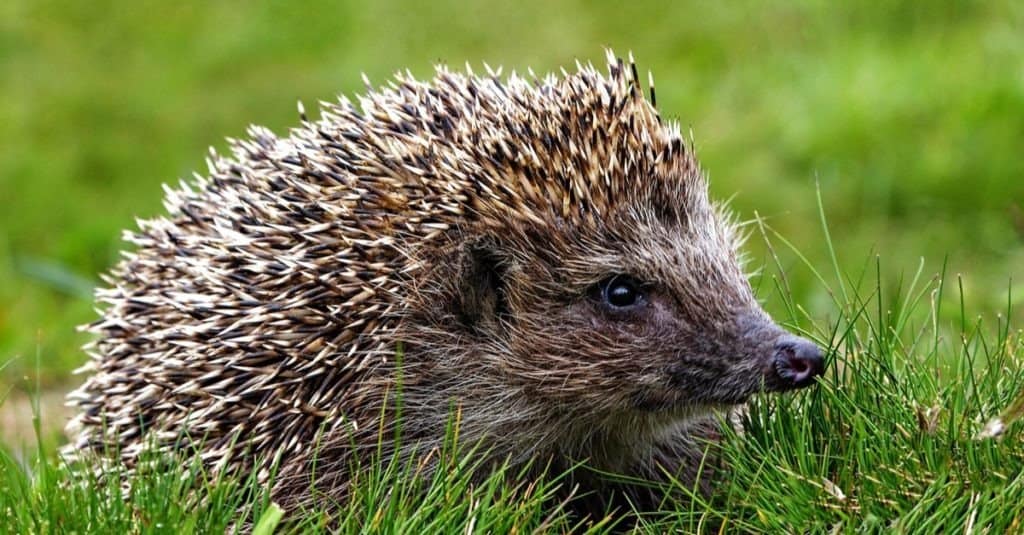
Hedgehogs inhabit parts of Europe, Asia, Africa, and New Zealand.
©SakSa/Shutterstock.com
Appearance
Identified as small mammals, hedgehogs have cone-shaped faces. They have short legs, and their entire body (apart from their face) has sharp spines that can hurt anyone around them. As closely as they resemble porcupines, the two mammals are not closely related. The spines are strongly attached to the skin, making it nearly impossible for them to be removed without immense force.
The quills of these animals can easily penetrate the surface of any mammal’s skin, including humans. With this puncture, bacteria and other germs can quickly spread, putting attackers at risk for further damage beyond the initial puncture.
Some of the bacteria associated with this wound can cause problems like rashes, fevers, and pain in the stomach. Anyone that has regular contact with these animals should wash their hands well, reducing the risk of spreading disease.
Individuals that regularly handle hedgehogs are at low risk of accidentally puncturing the skin since their weight is evenly distributed. The only time that this wound becomes risky is when the animal feels unsafe, naturally defending itself against danger.
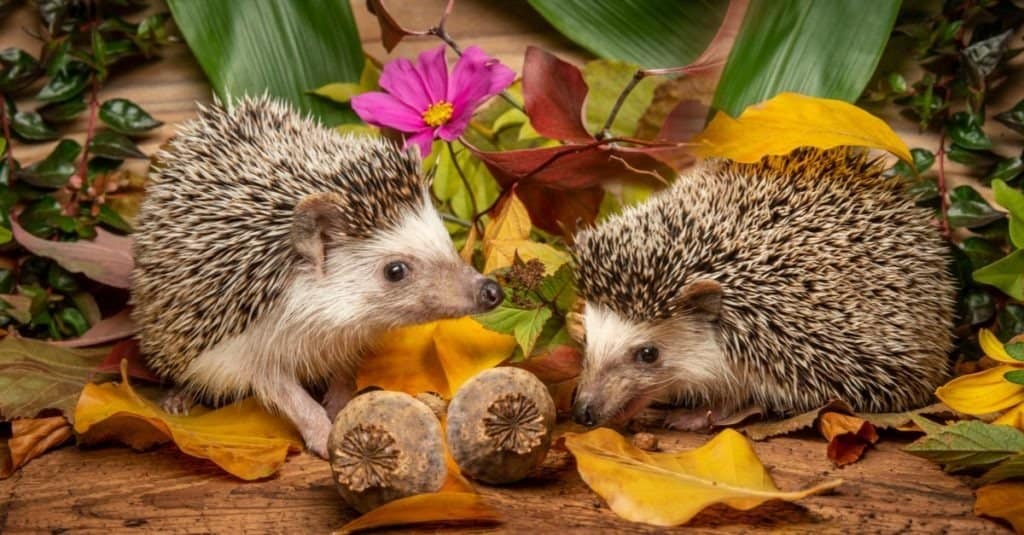
Hedgehogs have cone-shaped faces, short legs, and their bodies (apart from their faces) have sharp spines.
©Kuttelvaserova Stuchelova/Shutterstock.com
Behavior
In their natural setting, hedgehogs are usually solitary animals. They are nocturnal, taking the night to hunt down and forage food while sleeping during the day. When sleeping on summer and spring days, they make nests for themselves as a home. The diet of the animal is made up of insects and other invertebrates, though they are not very high on the food chain.
Hedgehogs, upon sensing danger, roll themselves into a sharp pricky ball. They are known to anoint themselves by licking any new scent that they like, licking their quills to have the new scent on themselves.
Even though these animals are often kept as pets, they might not enjoy being petted right away. You will have to earn the trust of a hedgehog so that it begins to relax and enjoy when you touch it. Learn more about the most interesting non-traditional pets here.
This animal with spikes is not usually aggressive, leaving its quills to defend it if it needs it. Hedgehogs will make hissing noises and sometimes bite at a threat, but they don’t seek out animals and humans to attack. There is a strikingly low risk of being harmed by a hedgehog since they are more defensive than aggressive.
When hedgehogs are relaxed, their quills are not that sharp. Even in their most tense moments, it is highly unlikely that a hedgehog would draw any blood from humans, though abrasions can occur.
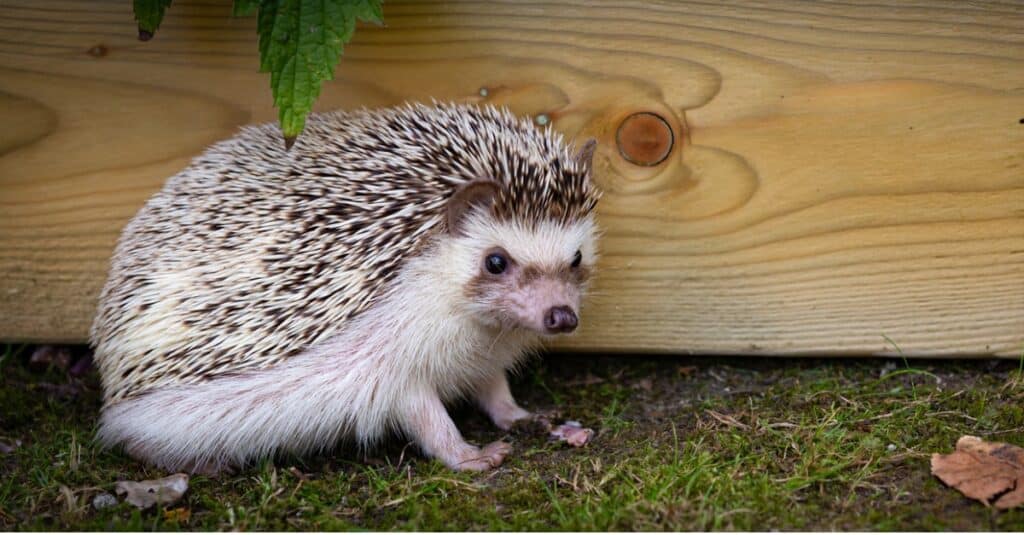
When hedgehogs are relaxed, their quills are not very sharp.
©HildaWeges/Shutterstock.com
Habitat
There are a variety of places around the world where these animals find comfort in living, and they will build a nest when they find the place that they want to stay. They usually find their comfortable habitat in very wet and extremely dense pine forests.
Mostly, hedgehogs can be found in Britain. Besides that, they are also scattered in upland areas including the sides of the mountains and the moorlands. They also love residing on the edge of woodlands.
Sources suggest that wild hedgehogs are originally from Africa, Europe, Asia, and New Zealand. Though they have become increasingly popular in the United States as well, they don’t naturally exist in the wild. Much of their presence in the country is due to being bred as a pet.

Hedgehogs can be found in
Britain
, and also in upland areas including the sides of the mountains and the moorlands.
©I, Jpbw, CC BY-SA 3.0, via Wikimedia Commons – Original / License
Diet
These animals are nocturnal and eat only at night. As a pet, hedgehogs should only be fed high-quality hedgehog food, which can be found in specialty pet food stores. Some owners prefer to shop for the natural foods that they would get in the wild.
In the wild, they eat a variety of things like several insects. They eat almost all invertebrates, frogs, carrion, rodents, baby birds, eggs of birds, and also fallen fruits from the trees in the dense forests.
Hedgehogs have a natural aversion to milk, making them lactose intolerant.

Predators and Threats
Like all other animals, hedgehogs also make an important part of the ecosystem and act as food to several living creatures. Most predators of the hedgehog are naturally carnivorous. However, when they hunt, hedgehogs will only seek out small mammals and insects.
One of the main threats that hedgehogs consistently face has been that of humans. Humans are primarily responsible for the deforestation of their habitats, as well as the way that they put these animals up for sale in pet shops.
What Eats Hedgehogs?
Hedgehogs don’t rank very high on the food chain, making them sources of nutrients for owls, wild dogs, mongooses, and mustelids. They also can be the prey of wolves and foxes, leaving them exposed during their sleeping hours.
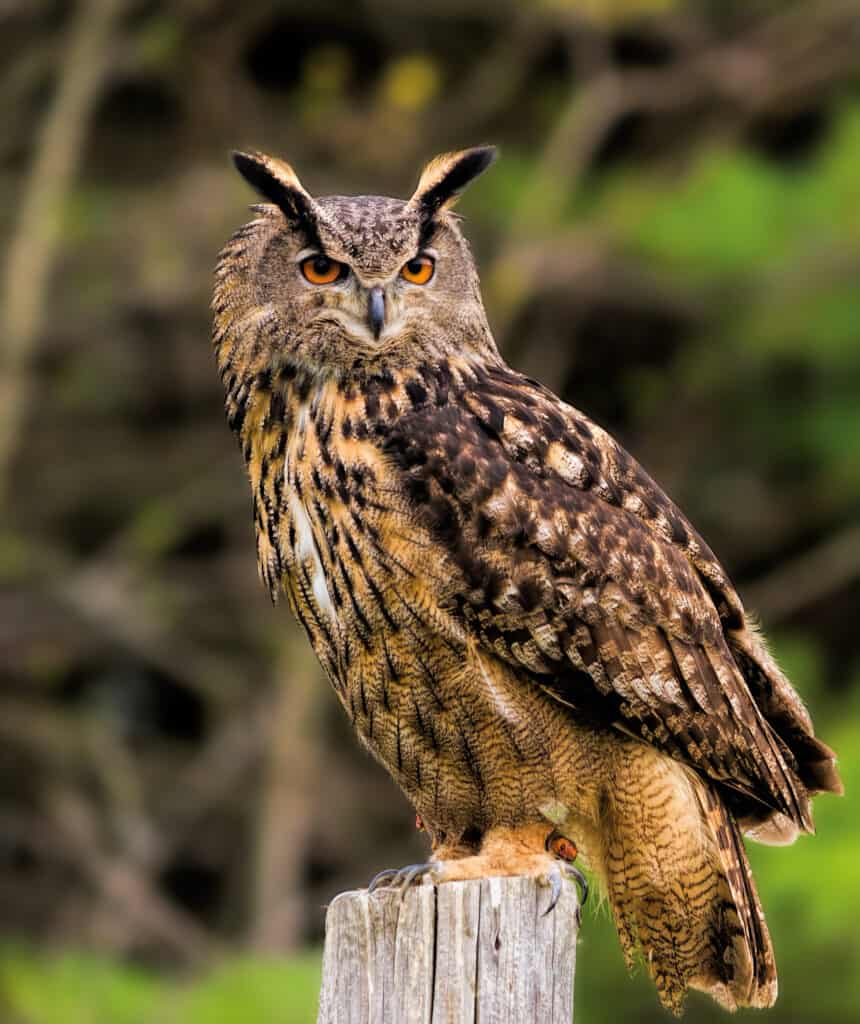
Owls are one of the predators of hedgehogs.
©LesPalenik/Shutterstock.com
What Do Hedgehogs Eat?
As far as their own nutrients, berries and similar plants are necessary to their diet, providing tons of nutrients in a small amount at once. When hedgehogs hunt, they look for small invertebrates and insects, like beetles, caterpillars, earthworms, and slugs.
Some pet owner websites will recommend attracting lost hedgehogs with wet dog food or cat food, though foods with fish should be avoided.
Reproduction, Babies, and Lifespan
Hedgehogs are usually solitary animals and are known to come together only for mating. During mating, the hedgehog female will produce an egg, which must be fertilized by a male. In an effort to get the attention of the female, the male will put up a show of circling, puffing, and snorting in a rhythm. It can breed throughout the year with no particular cycle.
When a female becomes pregnant, their gestation will typically last for no more than 40 days. Though it can be difficult to tell if a pet hedgehog is pregnant, owners should look out for frequent feeds and slight weight gain.
Each year, the hedgehog babies are born into groups that are called litters. These groups can comprise up to 11 babies, which are commonly known as hoglets. The hoglets will remain with their mothers for 4-7 weeks, during which time the mother will protect their young.
As a rule of thumb, never disturb a hedgehog nest. Mothers will sense the disruption and will notice a new smell on both the nest and their own young. If they do not recognize the scent, they will sometimes eat the young.
If the hoglets survive their childhood, they will depart on their own after a brief time. Hedgehogs usually have a lifespan of two to five years, but some hedgehogs can live up to 7 years.
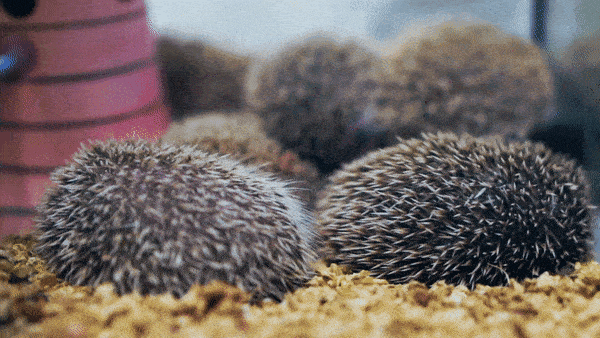
In the Zoo
Hedgehogs are commonly kept in zoos, though they are occasionally kept in homes as pets as well. They are usually fed quality hedgehog food in captivity, which can be purchased from specialty shops. The females and males are kept together so that they can naturally mate, rather than being artificially inseminated.
It is often said that hedgehogs can be kept in cages, provided that they are escape-proof. The cages of the hedgehogs should be as large as possible so that these animals cannot destroy them easily. As a protective measure, the base of the cage should also be very solid so that the hedgehog does not get hurt.
In some areas, it is illegal to keep hedgehogs as a pet. Some states that do not allow hedgehogs to be kept privately include California, Georgia, and Hawaii. It is also illegal within the city limits of New York City, Omaha (Nebraska), and Washington D.C. It is also against the law to bring hedgehogs out of Africa, according to reports from PETA.
It is estimated that, around the world, there are 17 different species. Though they were once in the millions, their total population dropped below one million in 2019.
View all 105 animals that start with HHedgehog FAQs (Frequently Asked Questions)
Are Hedgehogs herbivores, carnivores, or omnivores?
Hedgehogs are Omnivores, meaning they eat both plants and other animals.
What Kingdom do Hedgehogs belong to?
Hedgehogs belong to the Kingdom Animalia.
What class do Hedgehogs belong to?
Hedgehogs belong to the class Mammalia.
What phylum to Hedgehogs belong to?
Hedgehogs belong to the phylum Chordata.
What family do Hedgehogs belong to?
Hedgehogs belong to the family Erinaceidae.
What order do Hedgehogs belong to?
Hedgehogs belong to the order Erinaceomorpha.
What type of covering do Hedgehogs have?
Hedgehogs are covered in Spikes.
What genus do Hedgehogs belong to?
Hedgehogs belong to the genus Atelerix.
In what type of habitat do Hedgehogs live?
Hedgehogs live in dense vegetation and woodlands.
What is the main prey for Hedgehogs?
Hedgehogs eat insects, worms, and seeds.
Are hedgehogs’ carnivores, herbivores, or omnivores?
Hedgehogs are insectivores and omnivorous. They eat almost all kinds of invertebrates, birds, bird eggs, frogs, and even fallen fruits.
How much does a hedgehog cost?
Hedgehogs cost anywhere between $100 to $300.
Where can I buy a hedgehog?
The large chain stores usually do not have hedgehogs at all. But small, independently owned pet stores usually keep these animals.
Do hedgehogs make a good pet?
Hedgehogs are known to be great companions and also make great pets. However, due to their reverse sleep schedules, they have to be fed and taken care of during the late evening hours.
How long do hedgehogs live?
The lifespan of hedgehogs is about two to five years. They usually die of cancers and/or tumors.
What's the difference between a hedgehog vs. a porcupine?
Hedgehogs have a lesser number of spines than a porcupine. While the former has 5000 spines, the latter has about 30,000. The quills of the hedgehogs are very difficult to remove while that is not the case with porcupines.
Where do hedgehogs live?
Hedgehogs live in a variety of places. They are mostly found in very wet areas of Brazil. However, they are also in upland areas including the sides of the mountains and the moorlands as well as woodlands.
What is the scientific name of hedgehogs?
Hedgehogs go by the scientific name Erinaceinae. Further, they belong to the kingdom Animalia and phylum Chordata.
What are some of the predators of hedgehogs?
Some of the predators of the hedgehogs include almost all carnivorous, large birds, and badgers.
How many babies do Hedgehogs have?
The average number of babies a Hedgehog has is 5.
What is an interesting fact about Hedgehogs?
Hedgehogs are thought to be one of the oldest mammals on Earth!
How fast is a Hedgehog?
A Hedgehog can travel at speeds of up to 12 miles per hour.
What's the difference between a hedgehog and an echidna?
There are many differences between echidnas and hedgehogs. Hedgehogs are much smaller than echidnas, and echidnas have powerful clawed feet, while hedgehogs don’t.
What's the difference between a hedgehog and a groundhog?
There are many differences between a hedgehog and a groundhog, including their lifespans and sizes. Groundhogs dig complicated tunnels, while hedgehogs curl up into balls as their main form of defense.
Thank you for reading! Have some feedback for us? Contact the AZ Animals editorial team.
Sources
- National Geographic / Accessed December 27, 2020
- Be Chewy / Accessed December 27, 2020
- YPTE / Accessed December 27, 2020
- Hedgehog Street / Accessed December 27, 2020
- DW / Accessed December 27, 2020
- Hedgehog World / Accessed December 27, 2020
- Wikipedia / Accessed December 27, 2020
- Pet MD / Accessed December 27, 2020
- RSPCA / Accessed December 27, 2020











